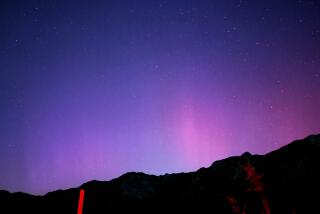The Arctic Circle
- Share via
It’s not just snow and ice, though that is the popular image. In reality, the land above 67 degrees north latitude supports a wide variety of plant and animal life. Temperatures in some “cold countries” are moderate, and during the summer there is sunlight 24 hours a day--a prime condition for vegetation. Temperatures within the Arctic Circle have been rising recently, leading scientists to search for a link to global warming. To learn more about the Arctic Circle, use the direct links on The Times Launch Point Web site: https://www.latimes.com/launchpoint/
LEVEL 1
Arctic Image Gallery: View a map of the Northwest Territories, which consist of the Arctic Islands, the Hudson Bay Islands and the area of Canada above 60 degrees north latitude. Learn about the people, the animals and the landscape through this collection of photographs. https://www.ssimicro.com/~xpsognwt/Net/gallery/images.html
Legends & Myths: Read traditional stories from Native American tribes as well as tales told by children living in the Northwest Territories. https://www.gov.nt.ca/kids/legend/legends.htm
Virtual Tundra Biome: Many plants that grow in the tundra have deep red leaves, which enable them to absorb more heat from the sun. Find out about the animals, plants and climate of the Arctic tundra. Meet some children who live in Anaktuvuk Pass, Alaska. https://mbgnet.mobot.org/MBGnet/vb/tundra/index.htm
LEVEL 2
Islandia--Your Guide to Iceland: NASA astronauts came to Iceland’s Askja volcano to train for the first Apollo mission to the moon. Discover other interesting facts about this country, including its history, government, geography and some helpful Icelandic phrases. https://islandia.nomius.com/
The Aurora: Brightly colored streaks against the night sky are a natural phenomenon that occurs at both the North and South poles. See diagrams that explain how the unusual atmospheric conditions that cause the northern lights are similar to how the picture tube in a TV or computer monitor works. https://www.pfrr.alaska.edu/~ddr/ASGP/STRSCOOP/AURORA/INDEX.HTM
Life and Art of an Ancient Arctic People: View art and artifacts from those who made the Arctic their home 5,000 years ago: first, the Paleo-Eskimos; later, the Dorsets. Learn about the ingenuity needed to survive the winter’s long periods of darkness and temperatures 30 degrees below zero. https://www.civilization.ca/membrs/archaeo/paleoesq/peexheng.html
LEVEL 3
Arctic Studies Center: Get unusual glimpses of the early cultures of Siberia and Alaska through the video and sound clips of this online museum. Find out about Arctic wildlife like reindeer, puffins and bald eagles. Read how native and non-native researchers are working together to gather ecological knowledge on the beluga whale. https://www.nmnh.si.edu/arctic/
Photo Tours of Nunavut: The strengths of a hunting culture--keen observation and visualization skills--are also the trademarks of accomplished artists. See how the exemplary artistry of the Inuit draws on its past. Learn about the beauty and adventures of life in modern Nunavut, Canada’s central and eastern Arctic region. https://www.arctic-travel.com/photo/index.html
The Arctic: Read about the effects global warming has already had on this ecosystem. https://www.panda.org/climate/arctic/
Launch Point is produced by the UC Irvine department of education, which reviews each site for appropriateness and quality. Even so, parents should supervise their children’s use of the Internet. This week’s column was designed by Anna Manring and Stan Woo-Sam.
EXPLORER’S QUEST
The answer to this Internet quiz can be found in the sites at right.
What is the best time of day to see the northern lights from Alaska?
Clue: See The Aurora
Tell Us What You Want To Know
Got a paper or project coming up? Just curious about something? Send us a topic, and we’ll consider it for a future Launch Point column. Write to us at The Times Orange County, 1375 Sunflower Ave., Costa Mesa, CA 92626. E-mail us at educ@latimes.com or leave a phone message at (714) 966-4550.
Answer to last week’s Quest:
Magma is molten rock that is underground. Lava is molten rock that breaks through the Earth’s surface.
More to Read
Sign up for The Wild
We’ll help you find the best places to hike, bike and run, as well as the perfect silent spots for meditation and yoga.
You may occasionally receive promotional content from the Los Angeles Times.






